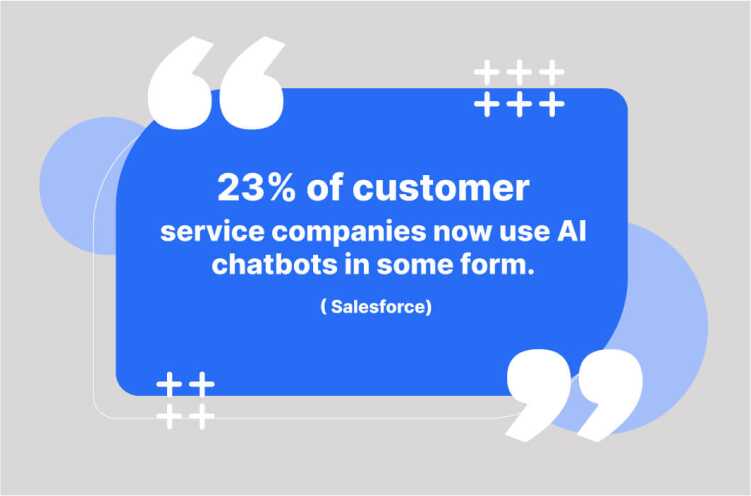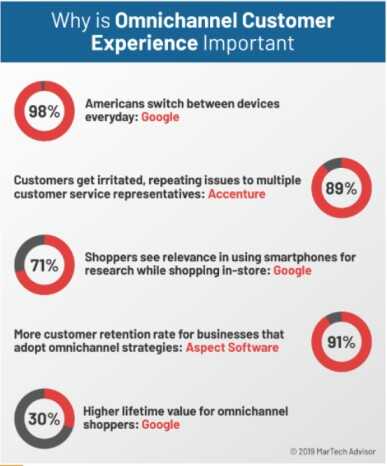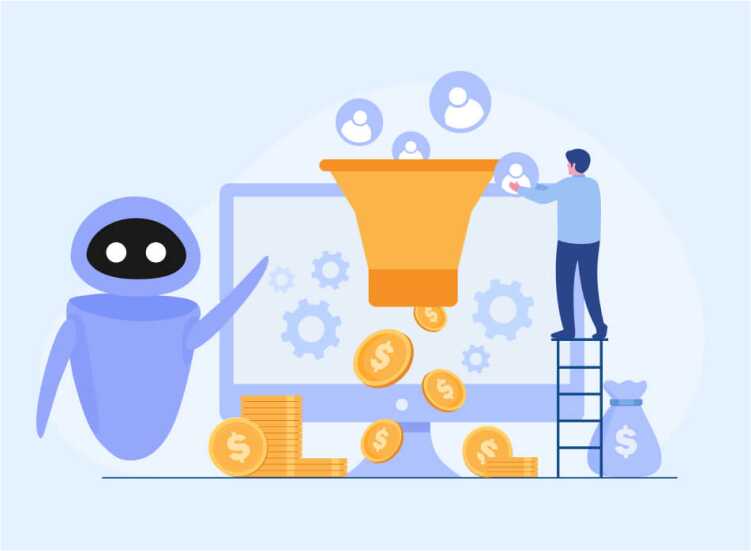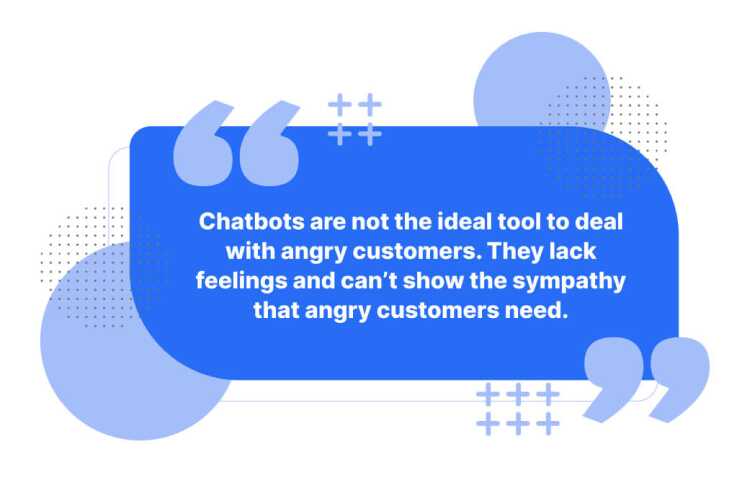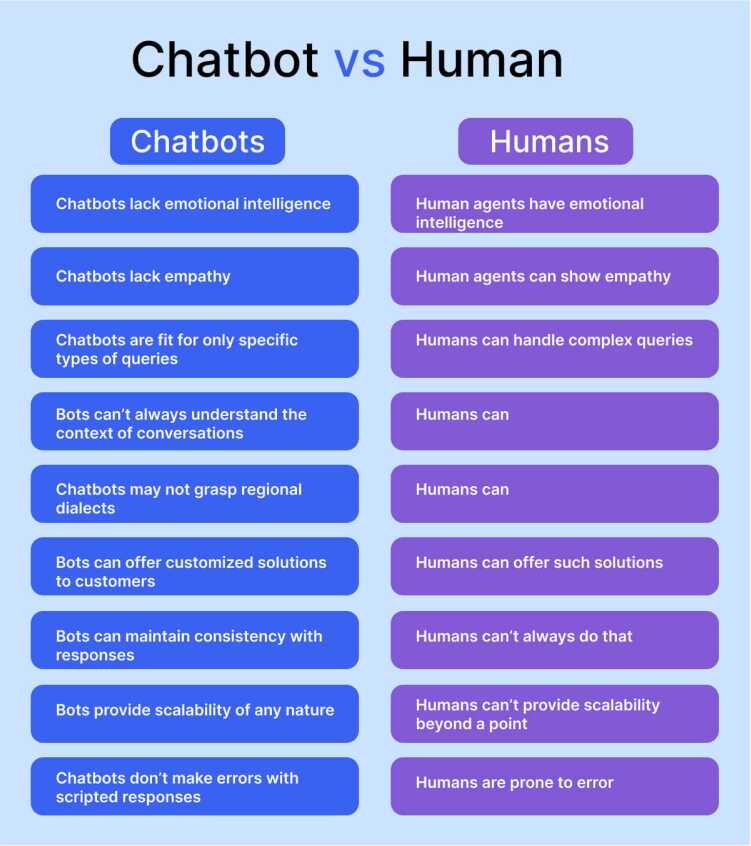Chatbots may be a new addition to customer service tasks but they are making positive noises all around. More companies now use them in some capacity or plan to use them in the near future to augment the delivery of service and enhance customer experience.
With chatbots growing in prominence and adding value to customer service operations, should this be an end to humans in customer service roles? The answer could be both a yes and no, depending on how one looks at it.
The chatbot vs human conversation is something that is going on for a while and it does not look like subsiding anytime soon. Amid all this, one thing is certain: chatbots are becoming increasingly advanced and they will soon handle more tasks and play a more prominent role in customer service than ever before.
However, humans are irreplaceable and their significance in ensuring excellent customer service can’t be replaced ever. There are many tasks and roles that chatbots can’t perform and only humans can do. This is the major reason why the delivery of customer service will forever need humans.
In this blog, we will do a comparative analysis of chatbots vs humans and see which one is a better fit for customer service.
So, let’s get started with a statistical analysis first –
Humans vs Chatbots for Customer Service: A Statistical Analysis
While humans have been the pillar of customer service for as long as it existed, chatbots are a relatively late yet imposing entrant to the domain. Despite being a late entrant, they are making customer service look effortless and more efficient than ever before. On the other hand, humans continue to play a major role in the delivery of customer service.
Let’s look at some key stats that would give a better idea of the changing dynamics of customer service –
23% of customer service companies now use AI chatbots in some form. ( Salesforce)
40% of consumers don’t care whether a chatbot or a human helps as long as they get timely help. ( Invespcro)
86% of consumers prefer humans over bots for getting support. (Forbes)
Utility of Chatbots for Customer Service
Chatbots are now integral to customer service as they can add value in so many ways. More companies include them as part of their customer service strategy to boost engagement and drive conversions.
Some of the major benefits of chatbots for customer service include –
1. Prompt responses
Customers always expect quick responses and prompt service. They want their queries to be answered almost immediately without having to wait. During peak hours, most agents are busy with a long queue of customers that stop them from offering prompt responses.
Even when agents have a centralized dashboard, they can handle only a limited number of customers at once and this can leave many of them waiting. When customers are made to wait longer, it can frustrate them.
Companies however can avoid this situation by using bots that can greatly ease agents’ workloads and also help customers get quick answers. Bots can not only ensure 24×7 support but also handle multiple customers simultaneously.
2. Omnichannel support
Customers love the flexibility and freedom of choosing a variety of channels to connect with a business. At the same time, they also expect businesses to follow them across platforms and ensure seamless conversation on the channel of their choice.
Not many businesses are providing this kind of experience and only a small percentage of companies are omnichannel. This leaves a huge gap between what customers expect with service and what they get.
Chatbots can prove very helpful in creating a system that connects all support channels. AI chatbots can be integrated with other marketing software and system to offer a consistent and connected experience to customers.
3. Consistent support experience
Customers feel bad when they have to repeat the questions and issues to different agents every time they reach out for support. This also creates discrepancies and inconsistencies in responses which is never an ideal scenario from the service point of view.
Even when the agents are trained to provide quality service, they may choose to offer varying responses to customers and this can dilute the experience. To avoid that, a company can add a chatbot to the service mix, train them and ensure consistent responses.
4. Leads and Sales Generation
Companies can use chatbots to do many manual tasks related to lead generation and sales. They can engage website visitors, provide answers to their queries, and collect information and quality leads. Bots can also schedule product demos and play a key part in guiding customers through their purchase journey.
More importantly, AI-powered chatbots can also proactively communicate with customers, educate them about products or services and contribute to nurturing prospects through the sales funnel.
Many e-commerce platforms have deployed chatbots to boost sales and guide customers through the platforms. All this can help companies achieve more leads and more sales by using bots.
5. Improved customer engagement
Chatbots can be used as virtual assistants to improve customer engagement by making conversations more interactive. They can engage visitors, offer personalized support and save them the hassles of browsing around.
AI bots are advanced and smart and can provide information based on the user’s input. This is how customer interactions become more personalized. When conversations are personalized, customers are more likely to feel engaged and this can prompt them to stay longer with the brand and even spend more.
6. Cost-effectiveness
The use of chatbots for customer service is helping businesses save considerable costs yet manage the same level of quality in service delivery. Since bots can automate routine tasks, this can ease the burden on staffing and training.
More so, many tasks can be automated which were earlier handled by human agents. This can free up human reps from the monotony of handling routine tasks and they can rather focus more on complex and urgent issues.
Significance of Humans for Customer Service
Chatbots are indeed advanced and sophisticated with the capability to handle most tasks related to customer service. But that does not mean humans have suddenly become replaceable or they are no longer required as service agents. On the contrary, a lot of customers still prefer human interactions over machines for various reasons.
Here are many reasons that show the significance of humans for customer service –
1. Handling complex situations
Customer service often involves complex and technical issues of varied natures where chatbots can prove ineffective due to being trained on a limited database. Such situations may require a bit of improvisation and an “out of the box” approach that a chatbot can never offer. Customers might feel frustrated when the issue demands meaningful help but the bot repeats the same answer on a loop.
More importantly, many customers still prefer one-on-one interaction with human agents that can help them through complex problems and provide a touch of personalization as well. Only a human agent can provide a coherent response or a detailed answer aligning with the specific situation. Depending on the complexity of the situation, bots might upset customers and even dilute their overall experience.
2. Dealing with angry customers
Angry customers are a common theme across industries. No matter how much great service you provide, some customers are going to get upset with the product, process, service or even handling of the query. Such customers need to be handled with a great level of care and a touch of caution as well, or else they might leave you forever.
Chatbots are not the ideal tool to deal with angry customers. They not only lack feelings but are also not equipped to show the sympathy that angry customers need. On the other hand, a human can detect frustrated customers, understand their feelings, and offer sympathy. Above all, humans can also suggest or offer an actionable solution that might dissuade the anger a bit.
3. Empathy
When customers approach a business, they expect agents to show empathy and understanding towards them and their problems. Showing empathy means putting oneself in the customer’s shoes and realizing their pain inside out. Bots can’t do that as they lack emotional intelligence and feelings.
On the other hand, humans are capable of offering empathy and being empathetic to customer issues. They are biologically wired to know the needs and feelings of customers which a machine can never do. For that reason, humans are irreplaceable in those tasks of customer service that require empathy as a key element.
4. Adaptability
Chatbots are getting more intelligent and smart by the day. The advancements in artificial intelligence technology together with language processing ability make them capable of handling a lot of tasks in customer service. The only problem with them is: they are limited to pre-programmed responses in most cases, which does not make them as adaptable as customers would ideally like.
Humans are adaptable, can adapt to different situations and needs, and offer personalized experiences as and where needed. They can think and act beyond the rulebook, can respond uniquely to situations, and solve issues that machines can never think of. The ability to adapt to different situations is the main reason why humans continue to make their presence felt in a big way in customer service tasks.
5. Physical review and inspection
Chatbots are best suited to tasks that need automation. But not all customer service tasks can be automated. In fact, there are many tasks and procedures that need the physical involvement of an agent such as checking product damage, reviewing the quality of the product or service, etc. Humans, not bots, are the only viable solution for things where a physical review is needed.
In addition, there will be situations where agents’ wisdom and intelligence are needed, and that too, in person, to complete tasks and ensure quality delivery of service. A chatbot can never work as they are not designed for tasks other than automation.
Chatbot vs Human: Limitations in Customer Service
While both chatbots and humans are cornerstones of great customer service, they come with their own set of limitations. Both have amazing capabilities but not only beyond a point. It’s therefore important to understand what and where they lack so that the delivery of customer service can be improved.
Limitations of Chatbots
- A lack of emotional intelligence is a big limitation of chatbots that stops them from understanding complex human emotions and responding to them.
- Chatbots lack the empathy that stops from them offering the personalized responses customers expect.
- Bots prove inefficient to handle issues that need human intervention as they are trained for only specific types of queries.
- The inability to understand context is a major drawback of chatbots that sometimes leads them to misinterpret customer queries or offer irrelevant responses.
- Chatbots are not able to grasp or decode regional dialects as they are best at understanding only standard language.
- Bots are not able to offer customized solutions to customers as they rely on pre-defined scripts only.
Limitations of Human Agents
- Human agents can not be available around the clock and it can cause delays in response times.
- Human agents are not able to maintain consistency in their performance due to several factors such as fatigue and stress and this can negatively impact the quality of customer service.
- With humans, the scalability of customer service operations will always be limited as they are not able to manage large volumes of queries simultaneously.
- The responses provided by human agents may vary depending on the situation and customer issues and this can cause inconsistency and frustration for customers sometime.
- Humans are prone to errors and some mistakes may happen with the solutions provided to customers.
Humans and Chatbots Together for Customer Service
Humans and chatbots can work together to create a seamless experience for customers. Both can exist together and complement each other for effective service delivery. This kind of arrangement can add value to customer service delivery.
Here are some ways in which a bot and a human can work together for customer service –
- AI chatbots automate routine inquiries and this can free up human agents to focus on more complex tasks requiring human intelligence and empathy.
- A chatbot can transfer the call or conversation to a human agent in situations where it’s not able to handle the query or provide an appropriate response.
- A chatbot can engage customers and collect information that humans can use for various tasks such as follow-up, lead generation, personalized support, etc.
- Trained chatbots can monitor customer feedback across channels and pass on the data to human agents for further processing. This can boost the quality of responses to customers.
- Bots need human interactions to learn, evolve and understand the complexities involved in managing customer queries.
Build A Powerful Chatbot with the REVE Platform and Enhance Customer Service
A business can build an AI-powered chatbot using the REVE platform and enhance the delivery of customer service. Building a bot is easy with our platform as it’s a code-less and hassle-free process.
In addition, we have a variety of other engagement tools as well such as video chat software and co-browsing software that can complement the bot and elevate the quality of service.
You can even pair up the bot with live chat software to ensure hybrid responses and improve the experience of customers.
Conclusion
It’s true that chatbots have changed the way customer service is delivered as they can handle most of the tasks that were earlier done by humans. But yes, the utility of human agents will forever be there for complex situations.
The right strategy for a business is to combine the best of the bot and human touch and drastically improve customer service.
You can sign up with us and check our top-class customer service tools for your business.

